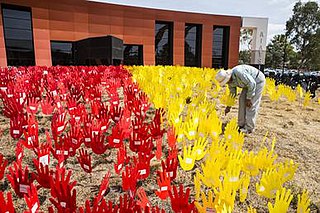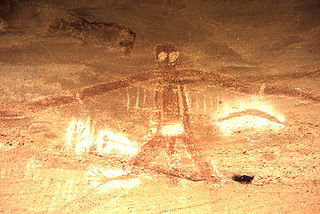Related Research Articles

Torres Strait Islanders are the Indigenous peoples of the Torres Strait Islands, which are part of the state of Queensland, Australia. Ethnically distinct from the Aboriginal people of the rest of Australia, they are often grouped with them as Indigenous Australians. Today there are many more Torres Strait Islander people living in mainland Australia than on the Islands.
Native title is the designation given to the common law doctrine of Aboriginal title in Australia, which is the recognition by Australian law that Indigenous Australians have rights and interests to their land that derive from their traditional laws and customs. The concept recognises that in certain cases there was and is a continued beneficial legal interest in land held by Indigenous peoples which survived the acquisition of radical title to the land by the Crown at the time of sovereignty. Native title can co-exist with non-Aboriginal proprietary rights and in some cases different Aboriginal groups can exercise their native title over the same land.

The second question of the 1967 Australian referendum of 27 May 1967, called by the Holt Government, related to Indigenous Australians. Voters were asked whether to give the Federal Government the power to make special laws for Indigenous Australians in states, and whether in population counts for constitutional purposes to include all Indigenous Australians. The term "the Aboriginal Race" was used in the question.

Commonwealth v Tasmania was a significant Australian court case, decided in the High Court of Australia on 1 July 1983. The case was a landmark decision in Australian constitutional law, and was a significant moment in the history of conservation in Australia. The case centred on the proposed construction of a hydro-electric dam on the Gordon River in Tasmania, which was supported by the Tasmanian government, but opposed by the Australian federal government and environmental groups.

The Australian Institute of Aboriginal and Torres Strait Islander Studies (AIATSIS), established as the Australian Institute of Aboriginal Studies (AIAS) in 1964, is an independent Australian Government statutory authority. It is a collecting, publishing and research institute and is considered to be Australia's premier resource for information about the cultures and societies of Aboriginal and Torres Strait Islander peoples. The Institute is a leader in ethical research and the handling of culturally sensitive material and holds in its collections many unique and irreplaceable items of cultural, historical and spiritual significance. The collection at AIATSIS has been built through over 50 years of research and engagement with Aboriginal and Torres Strait Islander communities and is now a source of language and culture revitalisation, native title research and family and community history. AIATSIS is located on Acton Peninsula in Canberra, Australian Capital Territory.
Australian archaeology is a large sub-field in the discipline of archaeology. Archaeology in Australia takes three main forms: Aboriginal archaeology, historical archaeology, and maritime archaeology. Bridging these sub-disciplines is the important concept of cultural heritage management, which encompasses Aboriginal and Torres Strait Islander sites, historical sites, and maritime sites.

The Hindmarsh Island bridge controversy was a 1990s Australian legal and political controversy that involved the clash of local Aboriginal Australian sacred culture and property rights. A proposed bridge to Hindmarsh Island, near Goolwa, South Australia attracted opposition from many local residents, environmental groups and indigenous leaders. In 1994, a group of Ngarrindjeri women elders claimed the site was sacred to them for reasons that could not be revealed. The case attracted much controversy because the issue intersected with broader concerns about Indigenous rights, specifically Aboriginal land rights, in the Australian community at the time, and coincided with the Mabo and Wik High Court cases regarding Native title in Australia.
Elizabeth Andreas Evatt, an eminent Australian reformist lawyer and jurist who sat on numerous national and international tribunals and commissions, was the first Chief Justice of the Family Court of Australia, the first female judge of an Australian federal court, and the first Australian to be elected to the United Nations Human Rights Committee.

The Bidjigal people are an Aboriginal Australian people whose traditional lands are modern-day western, north-western, south-eastern, and southern Sydney, in New South Wales, Australia. The land includes the Bidjigal Reserve, Salt Pan Creek and the Georges River. They are part of the Dharug language group, and there is debate as to whether the clan is part of the Dharug or Eora people.
Indigenous Australians or Australian First Nations are people with familial heritage to groups that lived in Australia before British colonisation. They include the Aboriginal and Torres Strait Islander peoples of Australia. The term Aboriginal and Torres Strait Islander peoples or the person's specific cultural group, is often preferred, though the terms First Nations of Australia, First Peoples of Australia and First Australians are also increasingly common.

An Australian Aboriginal sacred site is a place deemed significant and meaningful by Aboriginal Australians based on their beliefs. It may include any feature in the landscape, and in coastal areas, these may lie underwater. The site's status is derived from an association with some aspect of social and cultural tradition, which is related to ancestral beings, collectively known as Dreamtime, who created both physical and social aspects of the world. The site may have its access restricted based on gender, clan or other Aboriginal grouping, or other factors.
Indigenous Australian customary law refers to the legal systems and practices uniquely belonging to Indigenous Australians of Australia, that is, Aboriginal and Torres Strait Islander people.
Australian heritage laws exist at the national (Commonwealth) level, and at each of Australian Capital Territory, New South Wales, Northern Territory, Queensland, South Australia, Tasmania, Victoria, Western Australia state and territory levels. Generally there are separate laws governing Aboriginal cultural heritage and sacred sites, and historical heritage. State laws also allow heritage to be protected through local government regulations, such as planning schemes, as well.
The Aboriginal Cultural Heritage Act 2003 is legislation passed by Queensland Parliament, commencing in April 2004 to recognise, protect and conserve Aboriginal cultural heritage in the State of Queensland
The National Parks and Wildlife Act 1974 is the legislation passed by the New South Wales Parliament with the explicit intent of conserving the's natural and cultural heritage of the state of New South Wales; fostering public appreciation, understanding and enjoyment of its natural and cultural heritage; and managing any lands reserved for the purposes of conserving and fostering public appreciation and enjoyment of its natural and/or cultural heritage.

The Aboriginal and Torres Strait Islander Heritage Protection Act 1984, is legislation passed by the parliament of the Commonwealth of Australia to enable the Commonwealth to intervene and, where necessary, preserve and protect areas and objects of particular significance to Australia's Aboriginal or Torres Strait Islander peoples from being desecrated or injured.
Indigenous land rights in Australia, also known as Aboriginal land rights in Australia, relate to the rights and interests in land of Aboriginal and Torres Strait Islander people in Australia, and the term may also include the struggle for those rights. Connection to the land and waters is vital in Australian Aboriginal culture and to that of Torres Strait Islander people, and there has been a long battle to gain legal and moral recognition of ownership of the lands and waters occupied by the many peoples prior to colonisation of Australia starting in 1788, and the annexation of the Torres Strait Islands by the colony of Queensland in the 1870s.
The Aboriginal Heritage Act 1972 (AHA) is a law in the state of Western Australia governing the protection of Aboriginal cultural sites. The law protects all Aboriginal heritage sites in Western Australia, whether or not they are registered with the Department of Planning, Lands, and Heritage. The Minister for Aboriginal Affairs of WA must provide approval for any activity which will negatively impact Aboriginal heritage sites. Under the AHA, Aboriginal sites of outstanding importance may be declared Protected Areas. The AHA also provides protection for Aboriginal objects.
Constitutional recognition of Indigenous Australians has been campaigned for since 1910, including having an Indigenous voice to parliament enshrined in the Constitution.
References
- ↑ "Application for authorisation under the Aboriginal Heritage Act1988(SA): Kelaray Pty Ltd–Lake Torrens Murdie Exploration Program" (PDF). Consultation Information Package. 2020.
- ↑ CROW, H (2002) Conserving Aboriginal Heritage as posted on Conservation Council of South Australia's web page Accessed 6 March 2008
- ↑ "Aboriginal and Historic Relics Preservation Act 1965". South Australian Legislation. Retrieved 1 July 2020.
- ↑ "The Recognition of Aboriginal Customary Laws and Traditions Today Recognition through Legislation". Recognition of Aboriginal Customary Laws (ALRC Report 31). Australian Law Reform Commission. Archived from the original on 19 April 2012.
- ↑ "Protection under state and territory laws". Australian Government Department of Environment, Sustainability, Environment, Water, Population and Communities. Archived from the original on 5 June 2013.
- ↑ South Australia's Department of Environment and Heritage web page on heritage Archived 23 July 2008 at the Wayback Machine Accessed 6 March 2008
- ↑ EVATT, Elizabeth (1996) Review of the Aboriginal and Torres Strait Islander Heritage Protection Act 1984. Australian Government. Canberra.
- 1 2 3 4 5 EVATT, Elizabeth (1996) Review of the Aboriginal and Torres Strait Islander Heritage Protection Act 1984. Australian Government. Canberra. Pages 321-329
- ↑ "Aboriginal Heritage Act 1988". South Australian Legislation. Retrieved 18 June 2020.
- ↑ TransportSA (1999). Cultural Heritage Guidelines: A Handbook for Staff and Contractors (PDF). Government of South Australia. ISBN 0-646-37726-4.